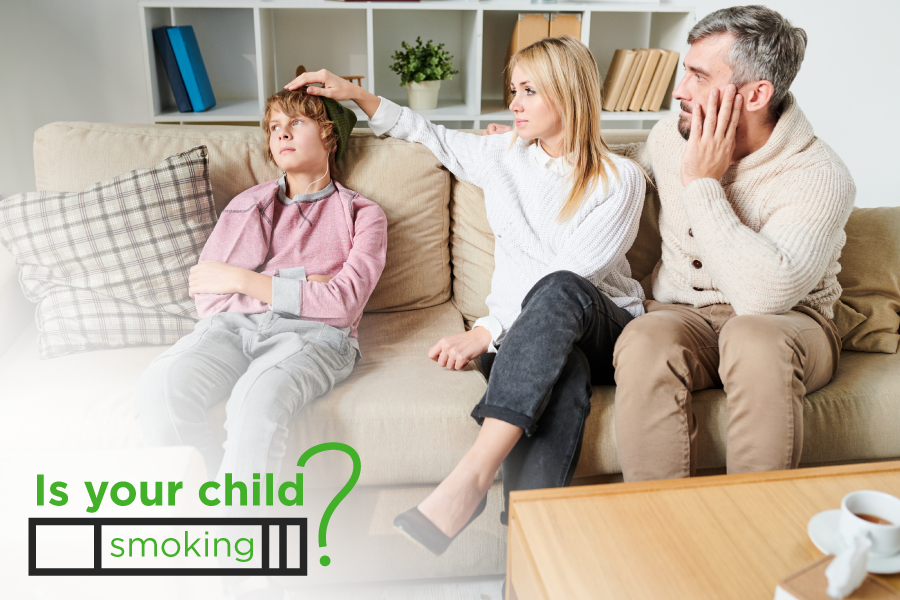Is Your Child Smoking?
By Shelby Tatomir on September 24, 2019 in Kid's Health

9 out of 10 smokers tried their first cigarette by the age of 18. Only 2 percent of smokers try their first cigarette after the age of 26. That means adolescence and early adulthood are critical years when smoking habits form. How would you handle it if you caught your child smoking? If the long-term health consequences are not enough to keep them away, we have tips and advice for confronting your teenager about smoking cigarettes.
Smoking is detrimental to everyone’s health. But, it’s much more dangerous for teens. Why? Because forming the habit of smoking cigarettes happens most often before the age of 26. The side effects of smoking are numerous, including lung cancer, oral cancer, and death. In 2016 alone, tobacco use resulted in over 7.1 million deaths worldwide. 6.3 million of those deaths were attributable to smoking cigarettes.
There are many oral health side effects to smoking cigarettes. Ensure your child is informed on all the consequences of smoking cigarettes.
Talk to your children about the dangers of smoking. Sharing real cause-and-effect visuals can give them a clear perspective on how unhealthy smoking is for us inside and out. If friends or relatives has been affected by tobacco-related illnesses, let your kids know. Sharing personal anecdotes may get them to tune in more.
No teen wants to discuss peer pressure with their parents, but if you frame it differently, they may be more open to a discussion. Ensure your teen understands why smoking is more than just a bad habit. Talk with them about being their own person and sticking to their own principles.
Share some real examples of the possible repercussions. There are both short term and long term consequences to being an active smoker or being exposed to secondhand smoke. You have an increased risk of catching infections. Smoking can increase an individual’s risk of anxiety or having a panic attack. Smoking also leads to a loss of collagen in the skin, causes wrinkles around the mouth and face, and causes acne.
Model healthy behaviors by not smoking, or try to quit if you do smoke.
Bad Breath from Smoking
We all know smoking causes bad breath, but “ashtray breath” isn’t the worst consequence. Smoking stains your teeth, damages your gum tissue, and reduces your ability to taste food. To make matters worse, smoking affects your sense of smell, so often times smokers may not be aware of how bad their breath really is. Avoid ashtray breath and quit smoking today.
Gum Disease and Smoking Cigarettes
Smoking is a major risk factor for developing gum disease. When gum disease is severe, it can cause teeth to fall out. Gum disease can be prevented by quitting smoking, going to the dentist regularly, and brushing and flossing.
Warning signs for gum disease include:
- Red or swollen gums,
- tender or bleeding gums,
- painful chewing,
- loose teeth.
- sensitive teeth,
- And gums that have pulled away from your teeth.
Stained Teeth from Tobacco
Smoking or using other nicotine products can make the enamel of your teeth more likely to stain. Once you’re hooked, teeth begin discoloring quickly. Regular visits to the dentist to get your teeth cleaned can reduce staining, but it will not be as effective if you continue smoking.
Lung Cancer and Oral Cancer
The long term effects of smoking cigarettes are damaging. According to the American Lung Association, “Lung cancer is the leading cancer killer in both men and women in the U.S.” Not all of these deaths are attributed to smoking, but 80 percent to 90 percent of lung cancer deaths are linked to cigarette smoking.
Because smoking can be glamorized in popular culture, it’s your responsibility to ensure your children understand the real consequences. Tell your children honestly and directly that you don't want them to smoke cigarettes, use e-cigarettes, or use any type of tobacco product. Give them clear, consistent messages about the risks and damaging effects of these products.
Looking for more information on how tobacco affects our oral health?